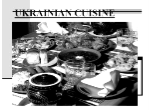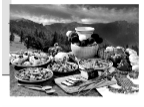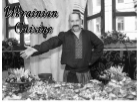Урок + Презентація "Traditional Food in Ukraine"
Клас 9
Тема: Food in Our Life
Тема уроку: Traditional Food in Ukraine
Цілі:
- формувати навички розуміння нових лексичних одиниць та вживання в усному і писемному мовленні;
- удосконалювати навичку вживання різних типів запитань;
- тренувати навички читання тексту з розумінням основного змісту;
- практикувати вміння вести бесіду у зв’язку з ситуацією;
- розвивати мовну здогадку й мовленнєву реакцію учнів; логічне мислення, пам’ять;
- виховувати повагу до традицій української кухні; виховувати самостійність
Обладнання : роздатковий матеріал, презентація по темі
План уроку
I. Підготовка до сприйняття іншомовного матеріалу.
1) Привітання. Бесіда Т- Cl про поточні події, настрій.
2) Мовленнєва зарядка. Робота з прислів’ями.
T.: I see, you are in a good mood and ready to enrich your knowledge in English. So, look at the screen. You see the jigsaw words there. Put the words in the correct order to make the proverb and explain it. (на екрані прислів’я – слайд 1)
- Eat at pleasure, drink with measure.
- Hunger is the best sauce.
- Every cook praises its own broth.
3) Повідомлення цілей уроку.
T .: This proverb can be the motto of our lesson because we’ll speak about our native cuisine. The topic of our lesson is “ Traditional Food in Ukraine”. So during the lesson you’ll be able to read, write and speak about Ukrainian cuisine and favourite dishes.
II. Розвиток мовленнєвих навичок та вмінь.
- Активізація лексичного матеріалу. Переклад та пояснення словосполучень. (слайд 2)
T.: Is it possible to speak about cuisine without checking the words? So, let’s refresh the words and word-combinations. Look at the screen read the word-combinations and give the definitions to them.
Meat products
Whipped cream
Rye bread
Cooked cereal
Cabbage rolls
Blood sausage
Dairy products
Folk beverages
- Повторення грамматичного матеріалу - типи запитань. Гра «Хрестики - нолики» (слайд 3)
T.: Can you ask different questions? Do you remember all of them? Let’s play the game “Crosses and Noughts”. Form two groups. Each group has to ask question according to the word in the table and name the type of question. The winner is the team which draw the line first. Good luck.
|
Do? |
What?
|
Have? |
|
Is? |
Who? |
…or…? |
|
…, is not..? |
Did? |
Why? |
- Письмо. Складання запитань з лексичними одиницями та поданим початком.(слайд 4)
T.: We’ve reviewed the types of questions. Now write the questions according to the beginning and word-combinations you see on this slide.
- What / dairy products?
- How / white bread?
- Why / meat (fish) products?
- Is / hot beverage?
- Do / cereal?
- Читання тексту «Traditional Food». Робота в групах. (роздатковий матеріал)
- Pre-reading activity.
T.: Do you know where the traditional Ukrainian cuisine comes from? Now you’ll work in groups with the parts of stripped text. You have to put all the parts in the correct order, and read the text.
- While-reading activity.
T.: Find the main idea of your part.
- After-reading activity.
T.: Write the plan to the text. Imagine you are in the USA. Tell about your cuisine using the plan. Retell the text briefly.
- Усне мовлення за малюнками про українську кухню. (слайд 5,6,7)



III. Заключна частина уроку.
- Підведення підсумків уроку. Самооцінювання.
T.: What have you learnt at the lesson? Which activity do you like most?
Analyze your and your classmates work at the lesson.
- Домашнє завдання.
T.: Write 10 questions on the topic,
prepare the project work (presentation) on the topic “Ukrainian Cuisine”**
Text
TRADITIONAL FOODS
Ukrainian cuisine is varied and rich in taste and nutritional value. Its development was influenced by the same factors as the development of material culture: geography and climatic conditions, plant cultivation and animal domestication, technological change, cultural influences, and economic relations with other countries.
Since ancient times Ukrainians have practiced a settled form of life based on farming. Archeological evidence shows that wheat, barley, and millet were grown in Ukraine 3,000 years ago. Rye was introduced about 2,000 years ago, and then buckwheat was imported from Asia in the 11th century AD. At that time cattle, sheep, hogs, and poultry were already raised. Beekeeping, hunting, and fishing were practiced.
As a result of Ukraine's trade relations with other countries, the cultivation of new plants, particularly from eastern and central Asia (egg, melons and eggplants), was introduced into Ukraine. The potato reached Ukraine from America through Europe in the 17th century, followed by corn, tomatoes, pumpkins, beans, cayenne peppers, cocoa and other plants. The introduction of these new products greatly enriched the variety of Ukrainian foods.
Since ancient times bread has held a special, primary position in the cuisine of the Ukrainian people. In general sour rye bread is the common type of bread produced in Ukraine, except in the southern and southeastern regions, where white-wheat bread is more common. Besides ordinary bread Ukrainians bake various ritual breads from special doughs. Ukrainian bread with its many variations has become quite famous.
For the common people bread was an object of reverence. Bread is used to bring divine blessings to the commencement of every farm task, the marriage ceremony, the birth of a child, and the move to a new home. As a sign of hospitality, guests of 69 honor at celebrations and public functions are greeted with a ceremonial offering of bread and salt.
Cooked cereal — whether wheat, barley, buckwheat, millet, oat, or corn grits—is an ancient Ukrainian food. The most commonly eaten cereals are buckwheat (kasha), millet, and, in the Hutsul and Transcarpathian regions, cornmeal (mamalyga or kulesha).
The favourite dishes made of flour are dumplings (halushky) and filled dumplings (varenyky) with various types of filling: cheese, potato and cheese, cabbage, meat, fish, buckwheat. Noodles, made of egg dough, are also frequently used, served either with soup or separately with cheese.
The potato is most widely used vegetable in Ukrainian cooking. It is a necessary ingredient in all soups, particularly borsch and cabbage soup. Boiled or' baked potatoes are served alone or with meat, fish, cheese, cabbage, mushrooms and so on. Potato pancakes are served with cheese or sour cream. Another important element in Ukrainian cooking is cabbage, particularly sauerkraut. which is used to make cabbage soup (kapusniak) or is served with meat, pea puree, or potatoes. Cabbage leaves are used in making cabbage rolls (holubtsi), which are filled with buckwheat or millet grits, rice or meat. Other vegetables such as onions, garlic, carrots, turnips, radishes, and cucumbers are frequently eaten raw. Sunflower and pumpkin seeds are usually dry-fried. Cucumbers, cabbage, tomatoes, and beets are pickled for the winter.
In a Ukrainian tradition a soup or borsch must be served for dinner. Various soups — made with meat, fish, vegetables, fruit or milk — are popular, but borsch remains the favorite. It is made of vegetables, among which beets and cabbage are predominant, and meat or fish.
Meat is usually eaten on feast days, Sundays, or at family celebrations. The most popular meat is pork and its products, such as ham, sausage, blood sausage, smoked bacon and salt pork. A lot of poultry is prepared, particularly chicken, baked in sour cream, stuffed, roasted, or cooked for soup. Fish is fried, poached, or baked with stuffing.
Foods prepared with milk, dairy products and eggs have long been a part of Ukrainian cooking. Soured milk is a favorite drink throughout Ukraine. Cottage cheese is eaten mixed with sour cream. A salty cheese from sheep's milk (brynza) is made in the Hutsul region and Bukovyna.
Fruits and berries, when in season, are eaten fresh or made into custards and compotes. Some fruits are prepared for winter by drying or preserving. The most popular dishes made from either fresh or dried fruit are uzvar, a compote, and kysil, a custard.
Bread kvas, fruit or cucumber broth, and birch sap are popular folk beverages in Ukraine. Tea is the most widely consumed hot beverage, followed by coffee and cocoa. Alcoholic beverages such as mead, wine, fruit liqueurs (nalyvka), alcohol with pepper and beer have been popular for many centuries.
There are significant regional variations in Ukrainian cuisine that resulted from the availability of different agricultural products,foreign influences, or even the conservatism of the common people in regard to change.


про публікацію авторської розробки
Додати розробку
